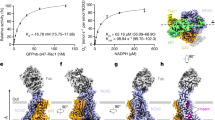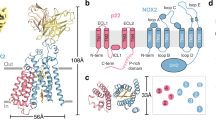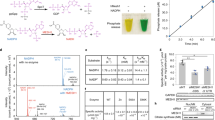Abstract
A Rac GTPase–regulated multiprotein NADPH oxidase is critical for the formation of reactive oxygen species (ROS) in phagocytic leukocytes and other nonphagocytic cells. NADPH oxidase reduces molecular oxygen to form superoxide anion in a two-step process. Electrons are initially transferred from NADPH to cytochrome b–associated FAD, then to cytochrome b heme and finally to molecular oxygen. We show here that Rac is required for both electron-transfer reactions. Mutational and biophysical analysis shows that Rac and p67phox independently regulate cytochrome b to catalyze the transfer of electrons from NADPH to FAD. However, they must interact with each other to induce the subsequent transfer of electrons from FAD to cytochrome b heme and molecular oxygen. This two-step model of regulation by Rac GTPase may provide a means of more effectively controlling the inflammatory responses of phagocytic leukocytes.
This is a preview of subscription content, access via your institution
Access options
Subscribe to this journal
Receive 12 print issues and online access
$209.00 per year
only $17.42 per issue
Buy this article
- Purchase on Springer Link
- Instant access to full article PDF
Prices may be subject to local taxes which are calculated during checkout





Similar content being viewed by others
References
Finkel, T. Signal transduction by reactive oxygen species in non-phagocytic cells. J. Leukoc. Biol. 65, 337–340 (1999).
Babior, B. M. NADPH oxidase: an update. Blood 93, 1464–1476 (1999).
Suh, Y. A. et al. Cell transformation by the superoxide-generating oxidase Mox1. Nature 401, 79–82 (1999).
Banfi, B. et al. A mammalian H+ channel generated through alternative splicing of the NADPH oxidase homolog NOH-1. Science 287, 138–142 (2000).
De Deken, X. et al. Cloning of two human thyroid cDNAs encoding new members of the NADPH oxidase family. J. Biol. Chem. 275, 23227–23233 (2000).
Bokoch, G. M. Regulation of the human neutrophil NADPH oxidase by the Rac GTP-binding proteins. Curr. Opin. Cell Biol. 6, 212–218 (1994).
Dorseuil, O. et al. Inhibition of superoxide production in B lymphocytes by Rac antisense oligonucleotides. J. Biol. Chem. 267, 20540–20542 (1992).
Roberts, A. W. et al. Deficiency of the hematopoietic cell-specific Rho family GTPase Rac2 is characterized by abnormalities in neutrophil function and host defense. Immunity 10, 183–196 (1999).
Ambruso, D. et al. Human neutrophil immunodeficiency syndrome is associated with an inhibitory Rac2 mutation. Proc. Natl Acad. Sci. USA 97, 4654–4659 (2000).
Voncken, J. W. et al. Increased neutrophil respiratory burst in Bcr null mutants. Cell 80, 719–728 (1995).
Quinn, M. T., Evans, T., Loetterle, L. R., Jesaitis, A. J. & Bokoch, G. M. Translocation of Rac correlates with NADPH oxidase activation: Evidence for equimolar translocation of oxidase components. J. Biol. Chem. 268, 20983–20987 (1993).
Philips, M. R., Feoktistov, A., Pillinger, M. H. & Abramson, S. B. Translocation of p21rac2 from cytosol to plasma membrane is neither necessary nor sufficient for neutrophil NADPH oxidase activity. J. Biol. Chem. 270, 11514–11521 (1995).
Dorseuil, O., Quinn, M. T. & Bokoch, G. M. Dissociation of Rac translocation from p47phox/p67phox movements in human neutrophils by tyrosine kinase inhibitors. J. Leukoc. Biol. 58, 108–113 (1995).
Heyworth, P. G. et al. Requirement for post-translational processing of Rac GTP-binding proteins for activation of human neutrophil NADPH oxidase. Mol. Biol. Cell 4, 261–269 (1993).
Abo, A., Boyhon, A., West, I., Thrasher, A. J. & Segal, A. W. Reconstitution of neutrophil NADPH oxidase activity in the cell-free system by four components: p67-phox, 47-phox, p21 rac1 and cytochrome b−245 . J. Biol. Chem. 267, 16767–16770 (1992).
Cross, A. R., Yarchover, J. L. & Curnutte, J. T. The superoxide-generating system of human neutrophils possesses a novel diaphorase activity: Evidence for distinct regulation of electron flow within NADPH oxidase by p67phox and p47phox. J. Biol. Chem. 269, 21448–21454 (1994).
Cross, A., Heyworth, P., Rae, J. & Curnutte, J. A variant x-linked chronic granulomatous disease patient (X91+) with partially functional cytochrome b. J. Biol. Chem. 270, 8194–8200 (1995).
Cross, A., Rae, J. & Curnutte, J. Cytochrome b-245 of the neutrophil superoxide-generating sytem contains two non-identical hemes. J. Biol. Chem. 270, 17075–17077 (1995).
Bromberg, Y. & Pick, E. Activation of NADPH-dependent superoxide production in a cell-free system by sodium dodecyl sulfate. J. Biol. Chem. 260, 13539–13545 (1985).
Cross, A. R. & Curnutte, J. T. The cytosolic factors p47-phox and p67-phox have distinct roles in the regulation of electron flow in NADPH oxidase. J. Biol. Chem. 270, 6543–6548 (1995).
Freeman, J. L. & Lambeth, J. D. NADPH oxidase activity is independent of p47-phox in vitro. J. Biol. Chem. 271, 22578–22582 (1996).
Koshkin, V., Lotan, O. & Pick, E. The cytosolic component p47(phox) is not a sine qua non participant in the activation of NADPH oxidase but is required for optimal superoxide production. J. Biol. Chem. 271, 30326–30329 (1996).
Diekmann, D., Abo, A., Johnston, C., Segal, A. W. & Hall, A. Interaction of Rac with p67phox and regulation of phagocytic NADPH oxidase activity. Science 265, 531–533 (1994).
Xu, X., Barry, D. C., Settleman, J., Schwartz, M. A. & Bokoch, G. M. Differing structural requirements for GTPase-activating protein responsiveness and NADPH oxidase activation by Rac. J. Biol. Chem. 269, 23569–23574 (1994).
Nisimoto, Y., Freeman, J. L. R., Motalebi, S. A., Hirshberg, M. & Lambeth, J. D. Rac binding to p67phox: Structural basis for interactions of the Rac1 effector region and insert region with components of the respiratory burst oxidase. J. Biol. Chem. 272, 18834–18841 (1997).
Heyworth, P. G., Bohl, B. P., Bokoch, G. M. & Curnutte, J. T. Rac translocates independently of the neutrophil NADPH oxidase components p47-phox and p67-phox. Evidence for its interaction with flavocytochrome b558 . J. Biol. Chem. 269, 30749–30752 (1994).
Freeman, J. L., Abo, A. & Lambeth, J. D. Rac “insert region” is a novel effector region that is implicated in the activation of NADPH oxidase, but not PAK65. J. Biol. Chem. 271, 19794–19801 (1996).
Joneson, T. & Bar-Sagi, D. A Rac1 effector site controlling mitogenesis through superoxide production. J. Biol. Chem. 273, 17991–17994 (1998).
Hiratsuka, T. New ribose-modified fluorescent analogs of adenine and guanine nucleotides available as substrates for various enzymes. Biochim. Biophys. Acta 742, 496–508 (1983).
Han, C. H., Freeman, J. L., Lee, T., Motalebi, S. A. & Lambeth, J. D. Regulation of the neutrophil respiratory burst oxidase. Identification of an activation domain in p67(phox). J. Biol. Chem. 273, 16663–16668 (1998).
Nisimoto, Y., Motalebi, S., Han, C.-H. & Lambeth, J. The p67phox activation domain regulates electron flow from NADPH to flavin in flavocytochrome b558 . J. Biol. Chem. 274, 22999–23005 (1999).
Cross, A., Erickson, R. & Curnutte, J. Simultaneous presence of p47phox and flavocytochrome b−245 are required for the activation of NADPH oxidase by anionic amphiphiles. J. Biol. Chem. 274, 15519–15525 (1999).
Guan, K. & Dixon, J. Eucaryotic protein expression in E. coli: An improved thrombin cleavage and purification procedure of fusion proteins with glutathione S-transferase. Anal. Biochem. 192, 262–267 (1991).
Ahmed, S. et al. Cryptic Rac-binding and p21Cdc42HS/Rac-activated kinase phosphorylation sites of NADPH oxidase component p67phox. J. Biol. Chem. 273, 15693–15701 (1998).
Segal, A. W. et al. Cytochrome b−245 is a flavocytochrome containing FAD and the NADPH-binding site of the microbicidal oxidase of phagocytes. Biochem. J. 284, 781–788 (1992).
Acknowledgements
We thank C. DerMardirossian for discussions and advice for cyt b purification; A. Cross for critical comments and technical advice; F. Wientjes for advice on p67phox mutant purification; and B. P. Bohl and J. Lu for technical assistance with protein preparation and molecular biology, respectively. Supported by USPHS grant M01 RR00833 to the General Clinical Research Center at The Scripps Research Institute; NIH grant HL48008 (to G. M. B.) and by a fellowship from the American Heart Association, Western States Affilliate (to B. D.).
Author information
Authors and Affiliations
Corresponding author
Rights and permissions
About this article
Cite this article
Diebold, B., Bokoch, G. Molecular basis for Rac2 regulation of phagocyte NADPH oxidase. Nat Immunol 2, 211–215 (2001). https://doi.org/10.1038/85259
Received:
Accepted:
Issue Date:
DOI: https://doi.org/10.1038/85259
This article is cited by
-
Organotypic hippocampal culture model reveals differential responses to highly similar Zika virus isolates
Journal of Neuroinflammation (2023)
-
Recent topics and advanced therapies in chronic granulomatous disease
Human Cell (2022)
-
The impact of reactive oxygen species in the development of cardiometabolic disorders: a review
Lipids in Health and Disease (2021)



